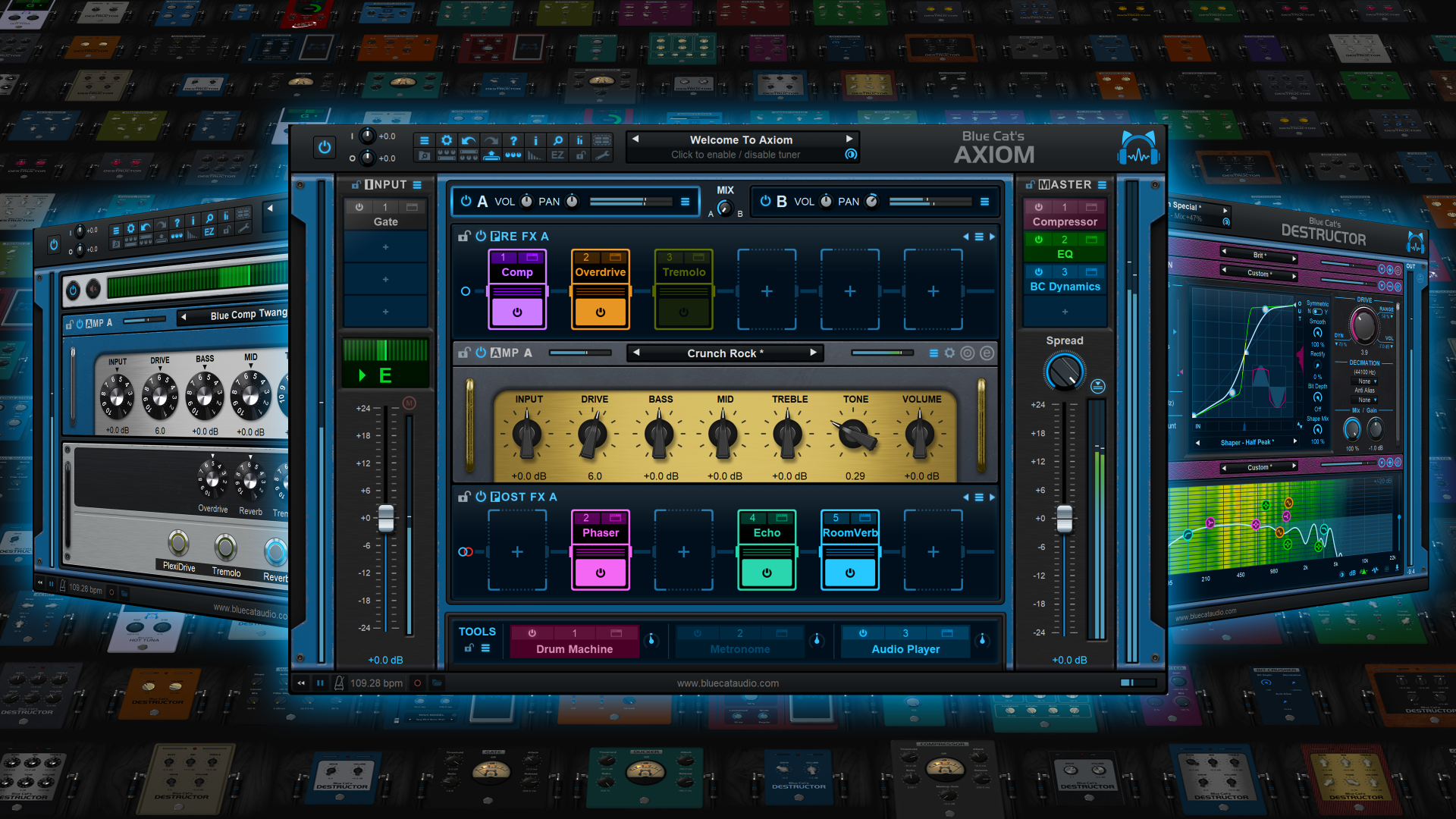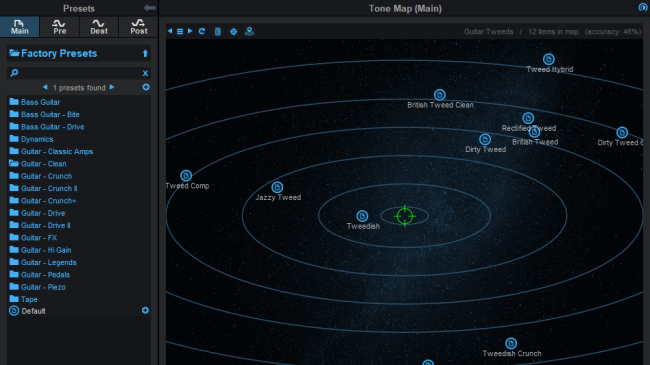Table Of Content
Introduction
Meet Blue Cat's Axiom: your versatile and open multi effects and amp simulation software for guitar and bass. Derived from the acclaimed Destructor plug-in for amp simulations, Axiom offers an infinite number of exceptional tones to enhance your musical expression with your axe.
In essence, Axiom caters to a wide range of musical scenarios, from recording and performance to sound design and experimentation. It empowers musicians, producers, and sound enthusiasts to achieve their sonic aspirations by combining realistic amp simulations, a wide array of effects, and the freedom to integrate their preferred plug-ins in any format. Whether you are in the studio crafting a masterpiece or on stage delivering a captivating live performance, Axiom is your go-to solution for pushing the boundaries of guitar and bass sound.
Axiom indeed offers a world of sonic possibilities thanks to its distinctive structure and signal flow:
- Two versatile amp simulation channels, each with pre and post effects, blend seamlessly for a lifelike amp experience.
- Discover unique amp simulation, offering exceptional tone, an authentic playing feel, and unrivaled tweaking capabilities for full control over your sound.
- Customize your tone with hundreds of presets or dive into the amp editor for complete control.
- Fine-tune your sound with additional input and master sections, boasting 4 effect slots each, and a built-in high-precision tuner.
- Safeguard your output with a brickwall limiter to prevent overshoot.
But that's merely the starting point. Axiom extends further, offering boundless potential for effects and creativity:
- Over 100 built-in effects, including creative delays, reverbs, distortion & fuzz pedals, modulation fx, wah and more.
- Unleash your inner pedal wizard and create your own: dive into creative delays and reverbs with the built-in version of Late Replies, sculpt your signature distortions, filters, and compressors with Destructor, and transform your pickups on the fly or refine acoustic guitar tones effortlessly with Re-Guitar!
- Seamless integration with third-party Audio Unit, VST, and VST3 plug-ins, expanding your sonic arsenal indefinitely.
- Enhance your performance with virtual instruments in the tools section, like metronomes, drum machines, sequencers, synthesizers, or the built-in audio player.
Axiom stands as your all-in-one solution, featuring an extensive library of hundreds of full-rig presets for both electric and acoustic guitar and bass. When used as an application, you can effortlessly play over backing tracks and record your performance with a single click.
If you are in search of amp simulation software without the effects, check out our Destructor plug-in. For a plug-in host & multi-effects processor without amp simulation, explore Blue Cat's PatchWork.
Typical applications: Limitless Guitar & bass amp simulation with effects, VST, VST3 and Audio Unit hosting, live performance, sound design, recording, creative exploration.
Credits: this plug-in includes several factory presets created by Hans Van Even.
System Requirements
MacOS
- An Intel or Apple Silicon processor.
- Mac OS 10.9 or newer.
- For the plug-in, any VST / Audio Unit / AAX compatible application (64-bit) .
- For the standalone application, a Core Audio compatible audio interface.
Windows
- An SSE2-enabled processor (Pentium 4 or newer).
- Microsoft Windows Vista, Windows 7, 8, 10 or 11.
- For the plug-in, any VST / AAX compatible host software (32 or 64 bit).
- For the standalone application, an ASIO, MME or WASAPI compatible audio interface (ASIO recommended).
For more information about supported platforms, see our Knowledge Base.
Demo Limitations:
- 5 instances of the plug-in allowed per session.
- The effect is bypassed for half a second every minute.
Installation
The standalone version does not require any host application and can be run without requiring any third party application.
The plug-ins versions cannot be run standalone: they require a host application (see the System Requirements chapter for more information). Depending on which host application you use, you might need to install the plug-ins in different locations.
Before installing one of the plug-in versions, you should close all your host applications.
Windows
Install
All versions of the plug-in provide an installation program. Follow the steps of the wizard to install the software on your machine. During the installation you will be asked where you want the software to be installed. For the VST version, you should install the plug-in inside the VST plug-ins folder used by your host application(s). The default path set in the installer should work for most applications, but you should check your host software documentation to know where it looks for VST plug-ins. For other plug-in types, you should just use the standard path.
Some applications will not automatically rescan the new plug-ins, so you might have to force a refresh of the plug-ins list.
Upgrade
When a new version of the software is released, just launch the new installer: it will update the current installation.
Uninstall
To uninstall the software, simply launch the "Uninstall" program that is available in the start menu or in the configuration panel. It will take care of removing all files from your computer.
Mac
Install
On Mac the plug-ins are available as drive images with an installer. After download, double click on the dmg file to open it. You can then double click on the installer (.pkg file) to install the package.
Note for Mac OS 10.15 Catalina or newer: you may have to right click on the installer and select "Open" instead of double clicking on the file to launch the installation if your computer is not connected to the Internet.
Upgrade
When a new version of the software is released, just launch the new installer: it will update the current installation.
Uninstall
To uninstall the software, simply remove the component(s) from their install location (move them to the trash):
- Standalone applications are installed in the /Applications folder
- AAX plug-ins are installed in the /Library/Application Support/Avid/Audio/Plug-Ins/ folder
- Audio Units (AU) are installed in the /Library/Audio/Plug-Ins/Components/ folder
- RTAS Plug-ins are installed in the /Library/Application Support/Digidesign/Plug-Ins/ folder
- VST plug-ins are installed in the /Library/Audio/Plug-Ins/VST folder
- VST3 plug-ins are installed in the /Library/Audio/Plug-Ins/VST3 folder
If you want to completely remove all settings and configuration files, you can also remove these additional directories that may have been created on your computer:
- ~/Library/Preferences/Blue Cat Audio/[Plug-in name and TYPE], where TYPE is VST, AU, RTAS or AAX: global preferences.
- ~/Library/Preferences/Blue Cat Audio/[Plug-in name]: license information
- ~/Documents/Blue Cat Audio/[Plug-in name]: user data, such as presets, additional skins and user-created plug-in data.
Please be aware that these directories may contain user data that you have created. Remove these directories only if you do not want to reuse this data later.
First Launch
Standalone Application
Once the application has been installed, simply double click on its icon to launch it. On Mac, the application will be located in the 'Applications' folder if using the default install location. On Windows, you will find it in the start menu.
The first time you launch the application, it will ask you if you want to configure the audio interface:

It is recommended to configure the audio interface before using the application, but you can still do it later by clicking on the "Edit/Audio Setup" menu. This opens the Audio/MIDI Preferences window reproduced below:
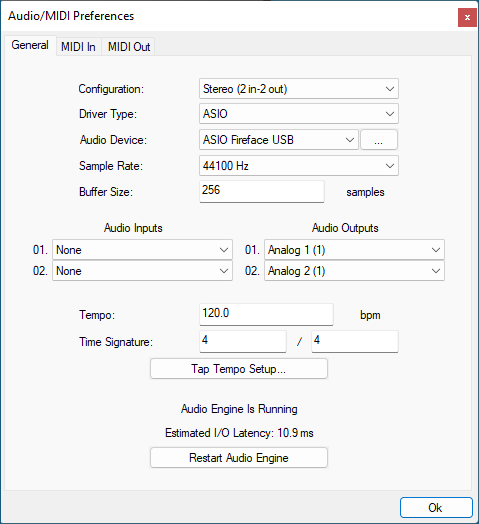
If the default setup displayed in the panel does not correspond to your needs, you can do the following:
- Choose the appropriate I/O configuration, if available.
- On Windows, choose the type of audio driver (ASIO is recommended. If you do not have an ASIO driver, we recommend using the ASIO4All driver).
- Choose the driver to use for audio input and audio output, if available (with ASIO, you can only choose a single driver for both).
- Select the sample rate and buffer size. Increasing the size of the buffer uses less CPU but adds latency.
- Select the audio inputs and outputs to use with the software.
- You can also set the tempo and time signature if relevant.
- Click on "Tap Tempo Setup" if you want to tap tempo with a MIDI controller.
Changes are applied to the application in real time and saved when closing the preferences window. You can see the status of the audio engine at the bottom of the window, as well as the estimated i/o latency (it depends on the sample rate, buffer settings and selected audio interface(s).
If the status of the engine is 'NOT Running', you may need to change the settings: try to increase the buffer size, change the sample rate (it might not be supported by the interface) or select another audio interface.
The MIDI In and MIDI Out panes let you select the MIDI devices to be used as input and ouput. You can either use them all, none, or select from a list:
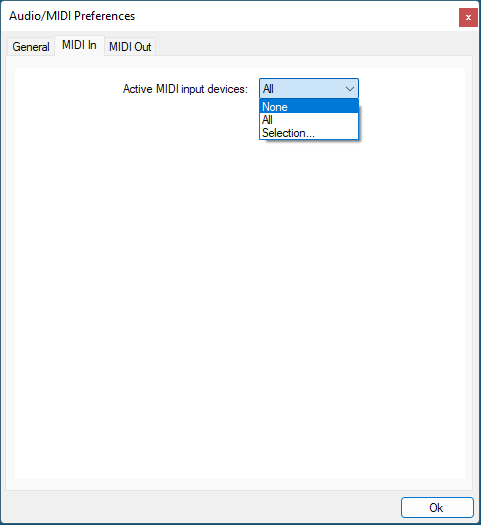
Once the this has been setup, you can close the window and start using the application.
Warning:Please make sure that all MIDI devices are connected and powered on before launching the application as they are scanned upon launch.
Standalone Application: Network Server
It is also possible to use the applications as a "slave" of another application that sends audio and MIDI with the Connector plug-in locally or over the network. To do this you should select the "Network Audio" driver type and "Connector Slave" driver.
Click on the button with 3 dots at the right of the driver name to access the connection settings (see the Connector Manual for more details):
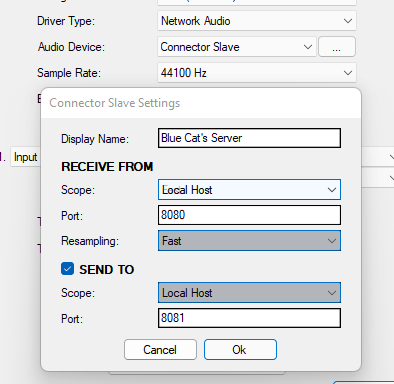
Note: in this mode, the application will not process audio unless some data is sent to it by an instance of the connector plug-in loaded into an active audio application.
Audio Plug-Ins
Blue Cat Audio plug-ins cannot be run standalone, they require a host application (see the System Requirements chapter for more information). Some host applications will require you to scan the plug-ins before they are available in the application.
If the plug-in is not available in the application, please check that it has been installed in the appropriate directory (with no host application running), and that the host application has scanned it.
Using Blue Cat's Axiom
Introduction
Blue Cat's Axiom is a multi-effects processor for guitar and bass with included amp simulation. It lets you insert third party plug-ins as well as built-in effects in many locations in the signal path.
Signal Path
Axiom is composed of an input effects section, followed by two parallel amp simulation channels (A/B), each one including pre and post effect chains together with an amp simulation module. at the output lies the master channel, with 4 effect slots, a stereo spread control, post gain and a brickwall limiter.

Three additional "tools" slots to host third party virtual instruments are available. Their output is mixed to the main signal after the limiter, and before the output gain, as shown above.
Note: despite its position in the Graphical User Interface (GUI), the tuner is not affected by the input effects.
Mono vs Stereo
Blue Cat's Axiom can be used with several audio I/O configurations, depending on the host application, plug-in format or the audio format of the track it is inserted on: mono, mono to stereo (M2S) or stereo.
When used with regular mono input, it is strongly recommended to use the mono to stereo configuration. In this case, the signal remains mono until the post effects of each amp channel. So input effects, pre effects and amp simulations only process a mono signal, which can save a lot of CPU cycles.
The GUI will show a different icon in pre and post effect chains to show if a mono or stereo signal is being processed:
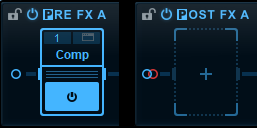
Amp Simulation
The two amp simulation modules available in channel A and B are based on the Destructor plug-in:

You can load amp presets and use the built-in controls to adjust the tone, or create your own amp simulation by opening the full amp editor or the tone maps browser. All amp presets are compatible and shared with the Destructor plug-in that also comes as a built-in effect.
Using the built-in Destructor, you can actually insert additional amp simulations anywhere in the signal path, or split the preamp and cabinet simulation in different locations (see the tips section later in the manual).
Built-In Effects
Blue Cat's Axiom includes more than 100 top quality built-in effects that can be used in all plug-in slots (effect pedals of channel strip slots), next to third party VST, VST3 or AU plug-ins. They include: distortion pedals, Bit Crusher, Chorus, Comb Filters, Compressor, Ducker, multiple delays and echoes, Harmonizer, EQ and IR Loader, Multimode Filter, Flanger, Frequency Shifter, Gain, Gate, Stereo Pan, Phase Shifter, Phaser, Pitch Shifter, Pitch Bender, Reverbs, Stereo Strip, Sweep Filter, Tremolo, Wah, Waveshaper, Audio file player, looper...

Axiom is also available as a built-in plug-in, so that you can load it into itself and share the presets... Built-in versions of the Destructor and Late Replies plug-ins are also included. They will share their presets and settings with the full versions if you already own them.
Built-in plug-ins offer the same preset management and control features as the main plug-in (MIDI learn, undo/redo, parameters range...). For more details about each effect and its controls, please refer to the included documentation ("?" icon in the toolbar of each plug-in).
EZ Mode
Version 2 bring a new "EZ mode", a simplified view perfect for live performances or quick presets exploration and tweaking. This mode provides easy access to essential controls without delving into intricate editing details.

When starting with Axiom, it is recommended to switch to EZ view and browse the numerous factory presets before diving deeper into the editing capabilities of the software.
Parameters Mapping & Macros
With Blue Cat's Axiom, it is possible to map sub plug-ins parameters in order to control them with host automation, an external control surface, or simply within the Axiom's user interface. Thanks to the included "learn mode", simply touching the knobs of your favorite plug-ins will let you assign parameters for external control (up to 42 controls are available).
Starting with version 1.7, it is possible to map several parameters to a single control and adjust the range of each parameter, to create macro controls that can adjust multiple parameters at once.
MIDI Preset Loading
It is possible to load presets using MIDI (with Bank Select and Program Change messages). More details about MIDI and presets loading is available in the presets section.
Multicore Processing
Axiom utilizes a multicore processing engine that can spread processing on separate processor cores for each amp channel and tools rack elements. It lets you use all your processor cores at the same time and load more effects or instruments at the same time.
Note: effects that are processed in series (one after the other) cannot be parallelized and do not benefit from multicore processing. Only A/B channels and tools rack elements can be processed independently.
The multicore engine can be activated or deactivated for each preset independently. When using very few plug-ins with low CPU usage in parallel, the cost of multicore processing can be higher than the benefits (you can check the CPU usage with the built-in CPU meter at the bottom right of the user interface).
Performance also depends on the host application and its own multicore processing strategy, so you may want to try and compare with or without multicore enabled.
The User Interface
Note: The main toolbar, menus and basic features available with all our plug-ins are detailed in the Blue Cat Audio Plug-ins Basics section.
Discovering the EZ Mode
Overview
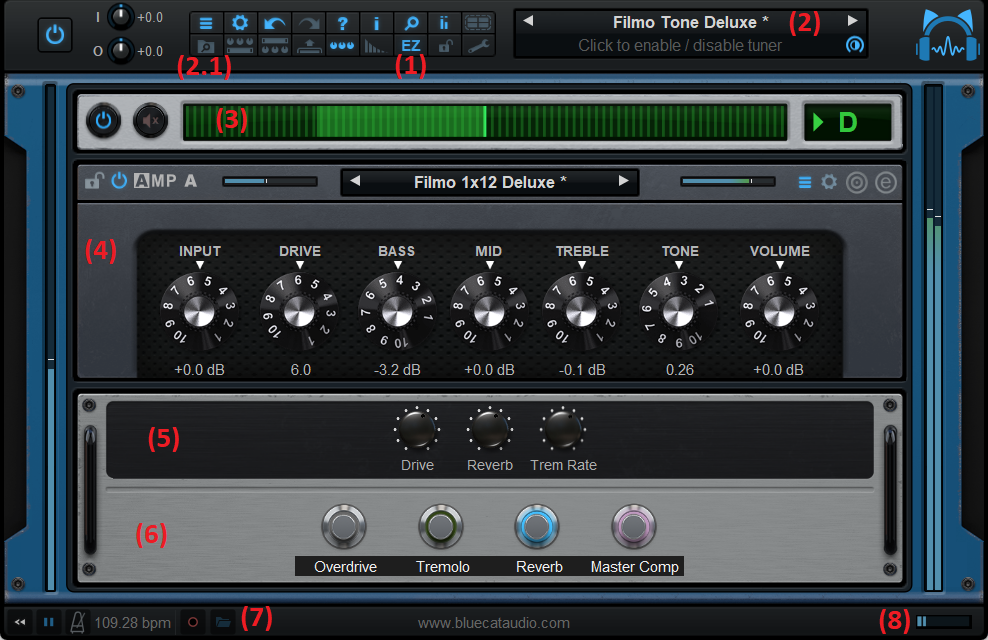
- Click on the EZ button to switch back forth between EZ and full mode.
- Use the presets area to load and save presets. The arrows let you go thru all presets quickly. Use the 2.1 button in the toolbar to display the advanced presets browser that offers more browsing and searching capabilities.
- Built-in Tuner. You can also mute the incoming signal when tuning with the mute button next to the power button.
- Amps Controls. Up to two amps may be displayed when parallel amp channels are used.
- Assigned Controls (if any) let you control the main parameters of the effects in the current preset. This can be configured with the macro controls editor.
- FX Switches: if any effects are loaded in the current presets (see the plug-in slots in the full view), they will appear here so that you can enable or disable them quickly.
- Audio recorder (application only): click on the red circle to record yourself, and then open the audio file by clicking on the folder icon.
- Real time workload meter that measures CPU load (becomes red when CPU load is too high).
Configuring the EZ View
Clicking on the knobs icon in the toolbar opens a menu to configure what is displayed in the EZ view:
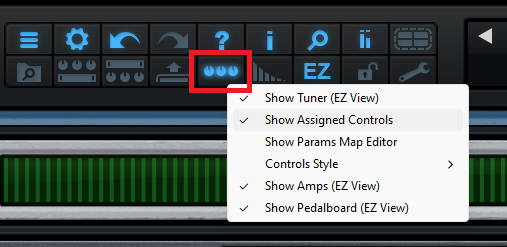
You can choose to display the amp(s), macro controls and footswitches (pedalboard) for the current preset. You can also launch the params map editor to modify or create new macro controls.
MIDI Control in EZ Mode
You can quickly access MIDI control settings in the EZ mode by clicking on the gear icon (there is also a separate gear icon for each amp):
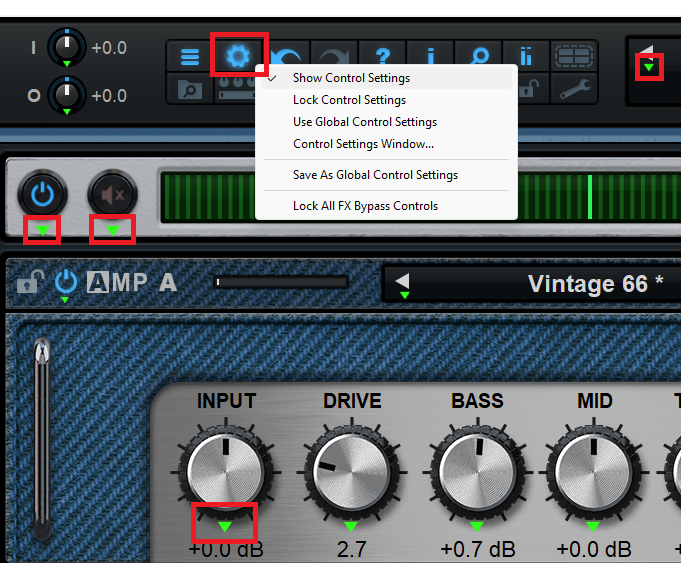
Clicking the green arrows under each control gives access to MIDI learn and other MIDI control settings. Once MIDI setup is complete, you can select "Lock Control Settings" so that MIDI control settings are not changed when switching presets.
Note: control settings lock is a separate setting for the amps (it can be accessed in amps edit mode using the same gear icon).
For more details about MIDI control capabilities in Axiom, check out the MIDI and automation section.
Full View - Overview
Switching back out of EZ mode shows the full user interface, with full access to all Axiom capabilities to craft you own tone in details. The complete user interface mostly follows the signal flow described in the previous chapter from left to right and top to bottom:
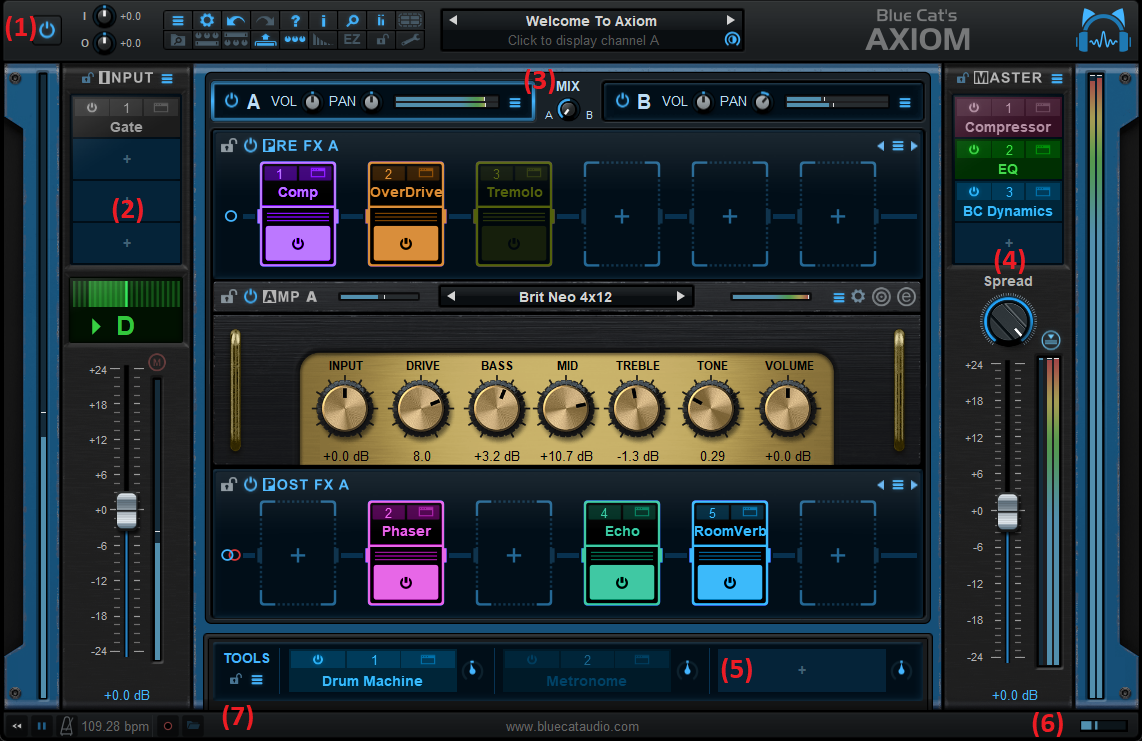
Main Components
- The main toolbar, with from left to right: the bypass button, in and out gain controls, the main toolbar buttons, the presets manager and text display LCD.
- The input section, with effect slots, tuner and pre-gain.
- The Amp channels.
- The output section, with effect slots, stereo spread, gain and limiter controls.
- The tools rack, to host third party virtual instruments.
- Real time workload meter that measures CPU load (becomes red when CPU load is too high).
- Transport & tempo controls, audio recorder (app only).
Meters
Level meters are available to monitor the audio level at many stages of the processor. Please note that no clipping happens between modules, so it is not a necessity to keep levels below 0 dB. It is however a good practice, as some built-in effects and third party plug-ins may be sensitive to the absolute audio level (dynamics processors, distortions...)
The reverse blue meter next to the output level meters displays the gain reduction performed by the brickwall limiter. Metering can be disabled in the main toolbar.
The main toolbar

- Main plug-in menu (access presets, global settings, ...).
- Show/Hide controls settings menu (MIDI learn, response curve, lock, effects bypass lock...).
- Undo/Redo.
- User manual.
- Open the about box.
- Global GUI zoom control.
- Show/hide level meters.
- Activate multicore support.
- Show/hide the presets browser.
- Show/hide controls for pre-fx pedals.
- Show/hide controls for post-fx pedals.
- Show/hide the tools rack.
- Assignable controls menu: show/hide assignable controls (controls mapped from hosted effects or amp sims), open the params map editor, or select the style of assigned controls.
- Activate tail spillover for Axiom, A/B channels or pre & post FX.
- Switch between "EZ" and full edit modes.
- GUI settings lock (to prevent GUI layout changes when loading presets).
- Show the preferences pane for plug-ins hosting.
Note: some controls may display additional information in the preset LCD (below the name of the current preset) when hovering the mouse on them, so you may want to keep an eye on this area!
Locks
Several locks are available to prevent changes while loading presets: when the lock is active, loading presets will not change the settings of a locked section. A general UI lock is also available in the toolbar, if you want to keep the same user interface settings (GUI layout, opacity, plug-in windows...) while browsing presets.

The Input Section
The signal enters the input section right after the main input gain. The lock located at the top of the input column locks the entire input section (including plug-in settings), so that they are not changed while loading global presets.
On the right you have access to a menu that manages the input effects chain: you can load/save presets or copy the entire chain to paste it in another instance or at another location in Axiom (pre or post fx, master fx...).
The tuner (disabled by default) can be enabled by clicking on it. You may want to disable it once in tune, to save CPU and avoid being distracted while playing.
Note: by saving the current state of the plug-in using the "Save as User Default" function, you can override the default state of the tuner.
At the bottom of the section, the slider adjusts the gain at the output of the section, with a level meter for monitoring.
A and B Channels
At the top of the middle section you will find the main controls for the A and B amp simulation channels:

Each channel can be enabled independently, with its own volume and pan controls. Clicking in the rectangular area around each channel selects the corresponding channel and displays its controls in the area below.
The mix knob lets you blend channels together, or smoothly switch between them. You can also click on the "A" and "B" letters to quickly switch between channels, or on "MIX" to switch between A, B and A+B.
The menu buttons for each channel let you load and save sub-presets that contain the settings of each channel separately. You can also copy/paste between channels.
Channels Details
Channels A and B are identical and offer the exact same user interface.
Pre and Post FX
Pre effects are applied before the amp simulation, whereas post effects are applied after, but they offer the same capabilities dedicated at chaining effects.

The entire section can be locked to keep its settings unchanged when loading global or channel presets. The power button next to the title can be used to disable the entire chain.
Each pedal slot can host a built-in or third party effect plug-in (more details later in the manual). Despite their different aspect, pedal slots have the exact same behavior and features as the other plug-in slots that can be found in the input and master sections.
At the top right of the section you will find a presets menu to manage sub-presets for the section. The settings can also be copied and pasted from and to other effect chains.
When enabled in the main toolbar, individual controls from hosted plug-ins can be displayed below the chain for direct access. It also works for third party plug-ins that expose their parameters.
Amp Simulation
At the core of Axiom you will find the amp simulator (one per channel):

Using the presets manager at the top of the amp, you can select an amp model from hundreds of presets (shared with the ) and then tweak the sounds with the knobs. Their behavior depend on the selected amp preset (they may have different range and the bass, mid and treble controls may affect different frequencies depending on the selected amp preset).
Like other sections, the amp simulator has a lock control and a bypass button.
At the top right of the amp module, you will find in order, from left to right:
- A menu button to access parameters mapping options, MIDI I/O assignments and presets.
- The gear icon to display the MIDI control settings buttons for the amp simulation module.
- The tone maps button to launch the tones explorer for the amp simulation: browse amp tones and create new amps in 2D with tone maps.
- The amp editor button to launch the amp simulation editor and access the "guts" of the amp simulation.
The amp simulator behaves like a built-in plug-in that is fully integrated into the user interface of Axiom. So in the first menu, you will find the same options as for plug-ins slots (except that you cannot load plug-ins).
When launching the amp editor, Axiom opens the GUI of the Destructor plug-in to give you full control over the simulation:
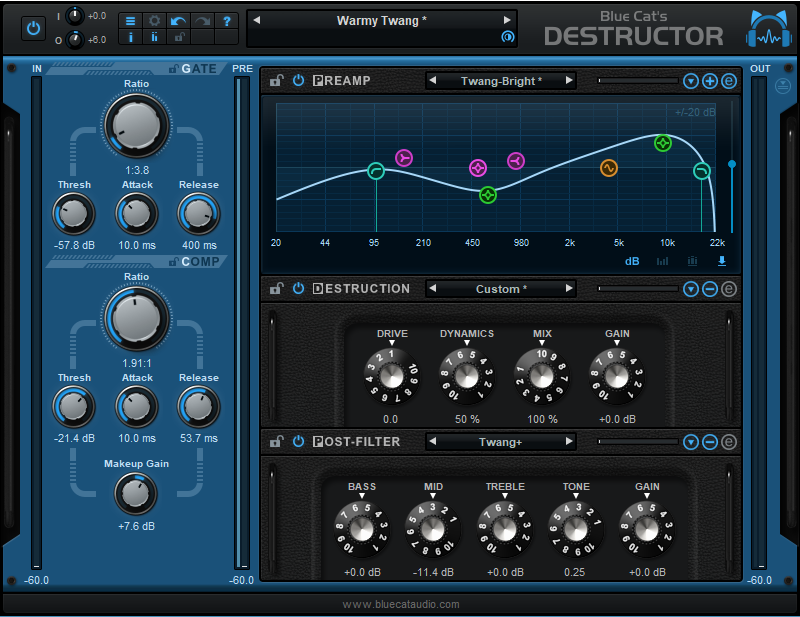
You can also customize the graphical user interface so that the look and feel of the amp matches the tone you have created: the look and feel selected in the amp editor is reflected in the main Axiom screen.
For more details about the amp editor and how to build your own amp tone, please refer to the Destructor user manual that is also available from the toolbar of the amp editor user interface (question mark icon).
Another option to browse and create new amp tones is to use tone maps: they let you browse existing amp presets in two dimensions and morph between them.
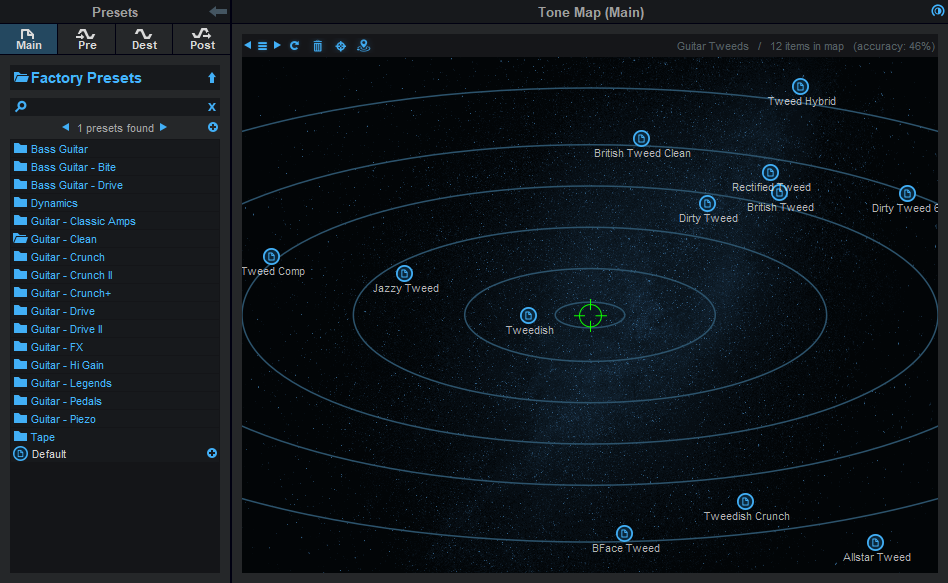
You can find your own tone without having to deal with the amp simulator and its parameters: just follow the presets, and find the right spot on the map.
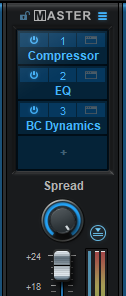
The Master Section
Like with the input section, the master section has its own lock and effect chain sub-presets controls, accessible next to the title.
Right before the brickwall limiter (that can be disabled with the icon at the top of the level meters), the stereo spread control can reduce the stereo width.
The post gain control lets you adjust the level before the brickwall limiter that protects the output of the plug-in (and your ears...).
The Tools Section
The tools section offers three additional plug-in slots for virtual instruments:

You can load the built-in audio file player or third party instruments (Axiom does not include built-in instruments) such as a drum machine, a metronome, synths, a sequencer... They will be mixed with the guitar signal at the output of the application or the plug-in. They can be controlled via MIDI or play in sync with the tempo if they support it.
The volume of each instrument can be adjusted using the knob next to it, and the section has a lock and presets menu as usual.
Workload Meter
The workload meter on the bottom right of the user interface gives an idea of the amount of cpu used by the plug-in to process audio frames:

It measures the realtime workload, which corresponds to the time spent processing an audio buffer compared to its duration. This value may be impacted by other tasks running on the system.
In general the average value gives a good idea of the cpu usage of the plug-in, while the peak value is an indication of potential audio dropouts (if larger than 100% for too long), that may be caused by overall system load (not just the plug-in's audio processing).
The workload meter becomes orange then red when the peak load grows. Hover the mouse on the meter to see numerical values in a tooltip.
Browsing Presets
In order to browse both factory and user presets, you can either use the simple presets menu or open the full featured presets browser from the toolbar that remains visible until you close it:

Click on preset files and folders to open them, or use the arrows to navigate between displayed presets. You can navigate upward in the folders tree by clicking on the current folder at the top. Type in the search box to find presets by name (it also searches in folder names). The search is performed recursively in the currently selected folder (displayed at the top).
Search Tips: you can search for multiple terms by separating them with commas. Wildcards are also supported (with * and ? characters), but they are applied to the full path of the preset. For example, to search for all presets containing the word "phase", type *phase* in the search box. To look for these presets only in the factory presets, you can type Factory Presets/*phase*.
Both global plug-in presets (main) and sub-presets for each section can be found in the presets browser - just click on the appropriate category to find them. The main tabs let you choose between main presets, channel A or B and "more":

For each channel, you can browse channel presets (containing settings for all subsections), or individual pre or post effect chains presets, or amp models:
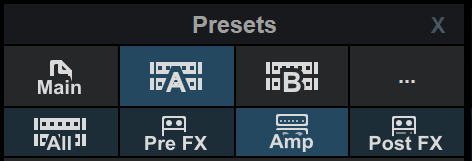
Input, master and tools racks settings can be found in the "more" tab ("..."):
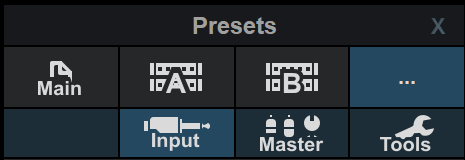
Using Built-in Effects, VST, VST3 or Audio Unit Plug-Ins
Note: before inserting VST plug-ins, it is strongly recommended that you setup your main VST plug-ins directory in the preferences pane, as detailed later in this manual (this setting does not affect VST3 plug-ins).
Warning: in a 64-bit application you can only load 64-bit plug-ins, and in a 32-bit application you can only load 32-bit plug-ins, unless your are using a third party bridging application.
Each plug-in slot lets you insert a plug-in. When clicking on an empty slot, the following menu appears:
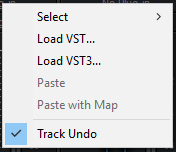
The "Select" item lets you load built-in effects, or choose a favorite third party plug-in directly from the menu if you have saved any.
Selecting "Load VST" will open a standard system window where you can select the VST plug-in you want to load. If the preferences have been properly set, the window should open the appropriate location where you can find the VST plug-ins.
Selecting "Load VST3" will open a standard system window where you can select the VST3 plug-in to be loaded.
On Mac, an additional "Load AU" menu item is available to load Audio Units. It opens a file open dialog in the standard location for Audio Units on your system. Note: if you want to load the system Audio Units provided by Apple, you will need to open the CoreAudio component located in the /System/Library directory (/System/Library/Components/CoreAudio.Component).
You can also choose to paste an existing VST, VST3 or AU plug-in if previously copied into the system clipboard from another slot. When using the "Paste with Map" command, if the plug-in in the source slot had mapped parameters, these parameters will be added to the map until no more assignable parameters are available.
Once a plug-in has been loaded into a slot, a mouse click will display the following plug-in menu that offers various controls over the plug-in:
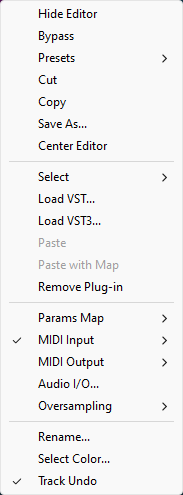
- Show (Hide) Editor: display or hide the plug-in's user interface.
- Bypass: toggle bypass for the plug-in.
- Presets: access the plug-in's factory presets if any, and load/save presets files in the plug-in's native format (fxb/fxp, vstpreset or aupreset).
- Cut: copy the plug-in and its settings into the system clipboard and remove it from the slot.
- Copy: copy the plug-in and its settings into the system clipboard. Once copied, it can be pasted to any other slot, in any instance of the Axiom plug-in (even in a different application).
- Save As: save the plug-in in the slot and its settings as a favorite. Favorites are saved in the plug-in documents folder and can be organized using folders to appear later in sub menus.
- Center Editor: bring back the editor of the plug-in to the center of the screen, in case you cannot find it.
- Select: select a plug-in and its settings from the favorites list.
- Load VST: load another VST plug-in in the slot (will replace the existing plug-in if any).
- Load VST3: load another VST3 plug-in in the slot (will replace the existing plug-in if any).
- Load AU (Mac only): load another Audio Unit plug-in in the slot (will replace the existing plug-in if any).
- Paste: paste a plug-in and its settings from the system clipboard into the slot.
- Paste with Map: paste a plug-in, its settings and mapped parameters from the system clipboard into the slot. Parameters are re-mapped in order, until no more assignable parameter is available.
- Params Map: lists the plug-in's parameters that can be mapped for automation, and lets you assign them to external controls (see the next paragraph).
- MIDI In: select the MIDI port(s) this plug-in is receiving data from (see below).
- MIDI Out: select the MIDI port(s) this plug-in is sending MIDI data to (see below).
- Audio I/O: opens the audio i/o routing window for this plug-in (see below).
- Remove Plug-in: remove the plug-in.
- Oversampling: select oversampling ratio and quality for the plug-in (see below).
- Rename: rename the instance of the plug-in. Setting an empty name reverts back to the plug-in's default name.
- Set Color: open the system color dialog to select the color for the plug-in slot (the color will also be dislpayed with the footswitches in EZ Mode).
- Track Undo: toggle undo tracking for the slot. If enabled, inserted plug-ins changes will be inspected and added to the Axiom plug-in undo history when possible. Please note that some plug-ins may not work properly when this feature is enabled. It is also recommended to disable this feature when controlling a plug-in with MIDI events generators such as Blue Cat's DP Meter Pro or Remote Control.
Once a plug-in has been loaded into a slot, the following buttons are available:
Clicking on the power button on the left will bypass/unbypass the plug-in in the slot. The button on the right can be used to show/hide the plug-in's editor.
Missing Plug-Ins
In some cases, it may happen that you are working on a workstation that does not have all plug-ins that were previously loaded into your Axiom session. In this case, the Axiom plug-in will display a "Missing Plug-in" message on corresponding slots. You can still continue working on your session: the Axiom plug-in will retain the state of the missing plug-ins as if they were here. The session can be saved later: the data for missing plug-ins will be saved as well, and the session can be restored later without losing data.
For VST and VST3 plug-ins, if the plug-in is missing because of a path issue (the plug-in is located in another directory, or the 64-bit version has a different name from the 32-bit version...), you can choose to relocate the plug-in:
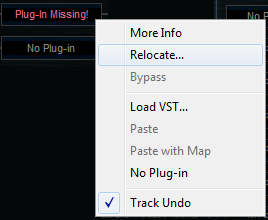
This lets you find the plug-in on your workstation and re-link to it. The state of the plug-in that was previously saved in the preset or the session will be restored, making sure all data is kept.
Note: the plug-in chosen with the relocate function has to be compatible with the plug-in that was originally loaded in this slot. Relocation will fail otherwise.
Mapping Parameters (one To One Quick Mapping)
The "Params Map" item in the plug-in menu lets you map sub plug-in parameters so that they can be automated or controlled with an external control surface. It also lets you view existing mapping for this plug-in if any:
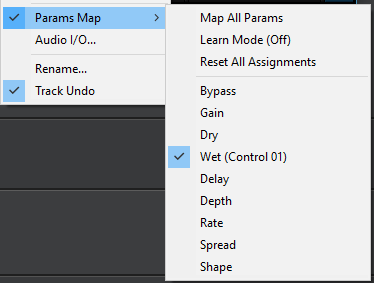
- Map All Params: assign all parameters of this plug-in to remaining controls (in the same order as exposed by the plug-in). The maximum number of parameters that can be mapped is 40.
- Learn Mode (on/off): when learn mode is on, touching a control in your plug-in's user interface will automatically add it to the parameters map (if the plug-in supports it). Once you are done with parameters assignment, you may want to disable learn mode to avoid mapping unwanted parameters.
- Reset All Assignments: removes all assigned parameters from the params map, for this plug-in. This frees all controls used by previously assigned parameters (for this plug-in only).
- All parameters available for assignment are then displayed in the menu. Clicking on a parameter toggles mapping on or off. When a parameter is mapped, the name of the external control (as displayed in the host application) appears next to it, inside parentheses.
Parameters Mapping works the following way: 44 parameters are available for mapping in Blue Cat's Axiom. They are named "Control 01" to "Control 44". When a sub plug-in parameter is selected for mapping, the first control available within Blue Cat's Axiom is used. Once mapped, the sub plug-in parameter and this control are linked together, so that any change to either of them is reported to the other.
This enables the sub-plug-in to expose its parameters to the outside of the Axiom plug-in. You can for example use these external controls for automation, MIDI control, control surface assignment etc.
If assigned controls are shown in Blue Cat's Axiom ("Show Assigned Controls" button), new knobs will appear when new parameters are mapped, until the maximum number of 44 controls is reached.
Macro Controls: The Parameters Map Editor
It is possible to access more advanced options for parameters mapping and create macro controls assigned to multiple parameters from multiple plug-ins by launching the Params Map Editor from the toolbar (assignable knobs icon).
The Map Editor is displayed in a separate window that you can re-size at your convenience:
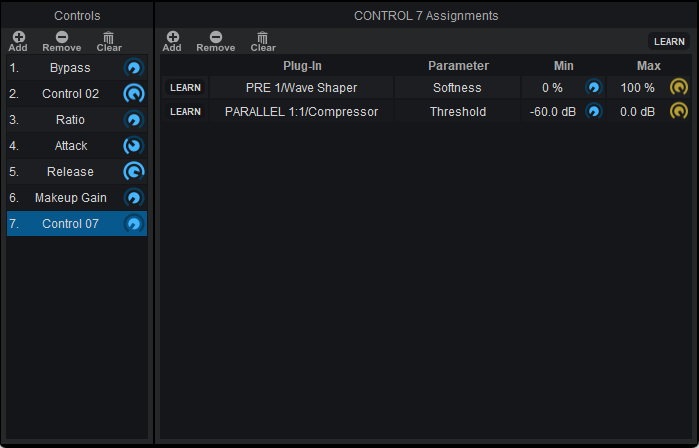
Available controls are displayed on the left (you can add or remove them with the icons on at the top), and when a control is selected you can see the parameters that have been assigned in the pane on the right.
Assignments can either be created manually (using the "Add" icon and then selecting the plug-in and parameter in the menus), or automatically with the learn button at the top right of the pane. When this assignment learn function is engaged, clicking or moving a knob of a plug-in should add the corresponding parameter to the list. Do not forget to disengage it when you are done or unwanted parameters might be added when touching the plug-ins later!
It is also possible to learn parameters individually using the learn button on the left of each line.
Once parameters have been added, their range can be adjusted using the knobs on the right (or by double clicking on the value). To reverse the range, simply invert the min and max values (using a min value that is larger than the max value).
You can also change the name of the controls by double clicking on them in the list displayed in the left pane.
It is also possible to change the order / add parameters by dragging and dropping items in the left column (it works between different instances too).
Internal MIDI Routing
Blue Cat's Axiom lets you build your own MIDI connections between inserted plug-ins and the host application. Each slot can be connected to multiple ports to receive and send MIDI events:

- Host: this port connects to the host application to send (MIDI Out) and receive (MIDI In) events. By default, all slots have their MIDI input connected to the Host.
- Port A to Port P: these are virtual ports that can be used to connect sub plug-ins together.
For the MIDI input of a plug-in you can additionaly choose to filter events by channel so that it receives all events for one or several selected channels only. If you just want the plug-in to receive all events without any filter, choose "All Channels" for the selected port.
Using virtual internal ports is simple: connect the output of a plug-in to a port, and the input of another plug-in to the same port. The two plug-ins will then be able to exchange MIDI data (from sender to receiver). Multiple plug-ins can be connected to the same port (as input or output). MIDI events will be gathered from MIDI Outs and redistributed to to all connected MIDI Ins.
However, there is a limitation in which plug-ins can be connected together:
- it is not possible to create feedback loops.
- only a plug-in that processes audio data before another can send MIDI data to this plug-in. It means that a plug-in can receive MIDI data from plug-ins that are located earlier in the audio processing chain only (see the signal flow above). If the plug-in is located in a parallel chain, it can also receive MIDI data from plug-ins that are located in parallel chains above it.
These limitations ensure causality and perfect synchronization of MIDI data exchanged between plug-ins, without latency.
Note: when connecting a plug-in to control its parameters via MIDI, you may want to disable undo tracking on this plug-in, to avoid that to many undo steps are recorded by Blue Cat's Axiom and reduce CPU usage.
Audio I/O Routing
Using the "Audio I/O" command in the plug-in menu, it is possible to manually change which audio channels are processed by each plug-in.
Automatic Selection
By default, Blue Cat's Axiom will automatically detect the number of channels to use for each plug-in depending on its own configuration.
About mono plug-ins: in automatic mode, mono plug-ins will process only the first audio channel, and the wet mono output will be copied to all channels. If you want to only apply the plug-in to one of the incoming audio channels instead, you can use the manual configuration.
Manual Selection
Automatic detection may however not work properly for some plug-ins, and you may want to change which channels the effect applies to (for multi-mono effects for example) That's what the audio I/O window is for:

When selecting a specific number of inputs and/or outputs instead of using "automatic", you can choose which channels are connected to each i/o for this particular plug-in:
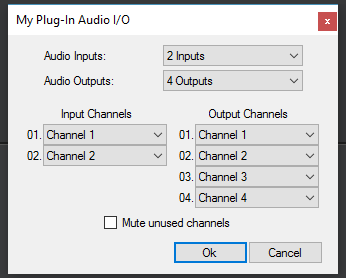
- if the same channel is selected for multiple outputs, only the last selected plug-in output will be audible (plug-in outputs are not summed).
- By default, all channels that are not used as outputs by the plug-in remain unchanged (copied from the same channels before the plug-in). For example, on a stereo configuration, if a mono plug-in is set to process only channel 1 and use channel 1 as output, channel 2 will remain unaffected. Select "mute unused audio channels" to mute these unprocessed channels instead.
Auto vs Manual
In automatic mode, Blue Cat's Axiom will automatically choose the best configuration according to its own audio layout. This is very useful if you are saving your plug-in chains to reuse them with different audio i/o configurations.
In manual mode, the number of inputs and outputs of the selected plug-in is selected and will not change. It means that you may not be able to use this particular configuration later with another number of audio channels.
Oversampling
Starting with Axiom V2, it is possible to have a plug-in process audio (and MIDI) at higher samplerates. You can select the oversampling ratio and resampling quality with the oversampling menu:

Oversampling can be useful for plug-ins doing non-linear processing (distortion, compression...) which do not have built-in oversampling capabilities and cause artefacts (aliasing). It may also benefit EQs (you can get smoother curves in the upper frequencies).
Oversampling may however result in other types of artefacts and will require more CPU to process the same amount of data. With high quality resampling, additional latency may also apply.
Warning: please note that some third party plug-ins may not support higher sample rates. Save your work before trying this feature on new plug-ins!
Tip: If you want to oversample an entire chain of plug-ins, you can load the built-in version of PatchWork in a slot, load your plug-ins inside, and choose to oversample the Patchwork plug-in containing the entire chain.
Note: The oversampling settings are saved when using the "Save As..." command to save the plug-in as a favorite.
The Preferences Pane

In the preferences pane, you can set the default VST plug-ins path by clicking on it or on the button labeled "...". This VST plug-ins directory is used for several purposes:
- It is the default directory that is opened when you want to load a VST plug-in.
- It is used as the root path when saving/loading presets that include VST effects: the path of VST plug-ins is saved relatively to this root path, so that you can reopen your sessions on different machines that may have different VST paths (typically on a Mac and a PC).
If you happen to have your VST plug-ins installed in several paths, we advise you to choose the VST path that contains most of your plug-ins. You can then use the "User VST plug-ins directory" to define an extra location for plug-ins. This extra path will be used by the Axiom plug-in as an alternative root path to load and save the plug-ins.
Please note that these paths are used for VST2 plug-ins only - they do not affect the location of VST3 plug-ins.
If the "Restore plug-ins editors on open" option is checked (default), when the Axiom plug-in is opened, inserted plug-ins user interfaces will be restored at the same position as when the Axiom plug-in was last closed. If the option is unchecked, all plug-ins user interfaces will be kept closed when re-opening the Axiom plug-in, and their position on screen will not be saved.
When the "plug-ins editors always on top" option is checked, the windows of the hosted plug-ins will be kept on top of all other windows. It can be useful when you want to make sure the hosted plug-ins remain visible all the time. Also, if you are using Cubase on Windows, you may want to check this option to fix the erratic behavior of Cubase's own "always on top" option.
Drag and drop support
The user interface supports drag and drop to manipulate plug-ins easily:
- drag and drop plug-ins between slots (copy or move).
- hold the alt key on Mac and Ctrl key on windows to copy (duplicate) a plug-in instead of moving it.
- drop the plug-in before another to insert it in the chain
- drag and drop plug-ins between several instances of Axiom or accross plug-ins (compatible with the latest preview of Late Replies, MB-7 Mixer and PatchWork).
- drag and drop .dll, .vst, .vst3, or .component files directly from the Finder or Explorer onto plug-in slots.
- drag and drop .plgnfo files (previously saved from the software) directly from the Finder or Explorer onto plug-in slots.
- drag the amp simulator, and drop it on any slot, like any other plug-in.
- drop the amp simulator onto channel A or B to copy the amp model to the other channel.
- Drag and drop amp channel (A or B) to copy the full channel to the other channel.
You can also drag and drop impulse response files (wav, aiff or flac) onto the amp simulator: they will be loaded into the post filter module of the amp (you may need to adjust the EQ or the filters if a built-in simulation was already loaded).
Using the Controls
The various elements of the user interface (knobs, sliders, buttons...) are simple and intuitive to operate, but more information about how to interact with them is available in the "Plug-ins Basics" chapter of this manual.
Operation
This section explores several common use cases for Axiom. A complete list of the parameters exposed by the plug-in is available in the next section.
Exploring the Presets
With its modular architecture, Blue Cat's Axiom offers a wide range of possibilities, so you may want to browse the presets first and progressively dive into each section: adjusting parameters, loading sub presets, etc.
This is especially true for the amp simulation module that also offers many sub-presets for each section, when opened in the amp editor (please refer to the Destructor user manual for more details).
Also, the built-in Late Replies plug-in is delivered with hundreds of presets for creative delays and reverbs to enrich your tone: check them out! You also can use it for classic spring reverb emulations or vintage tape delays or unbelievable harmony effects.
The EZ Mode is a good way to get started with Axiom and only access the main parameters of each preset. All factory presets are built as full guitar rigs with amps and pedals (even clean tone presets may have additional distortion pedals that you can activate). Macro parameters are also provided in each factory preset to quickly tweak the effects straight from the EZ view.
Creating Your Own Tone
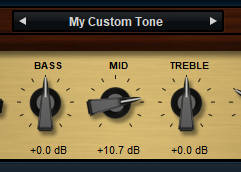
If you want to create your own tone from scratch, we recommend starting like this:
- Adjust the input gain so that input signal peaks are close to 0 dB, without exceeding it.
- Choose an amp preset, or create your own with the amp editor or the tones map browser (more details in the Destructor user manual).
- Adjust the drive and equalizer (bass, mid, treble) to your taste.
- Add pre and post effects, starting with reverb first and continuing with more "creative" effects.
Note: reverb settings usually have an impact on the spectral balance of the amp simulation, so you may want to adjust the equalizer of the amp simulation after adding the reverb. You can also set the reverb first before choosing your amp simulation preset.
Tip: mixing two amp tones using channels A and B can produce very interesting effects, but it is quite difficult to predict the result: unless you pan them left and right, the different responses of the amp simulations will deeply interact with each other. So if you know what you are looking for, you will often get the best results more quickly by adjusting a single amp simulation in details using the editor, rather than using both at the same time.
Controlling Axiom with MIDI
Axiom and built-in effects can all be controlled via MIDI (see the MIDI and Automation chapter) in several ways, as shown in this getting started tutorial.
Program Change
You can load global presets for Axiom using MIDI Program Change messages, when the feature is activated in the main presets menu. It also works for individual built-in plug-ins - and some third party plug-ins may also support it.
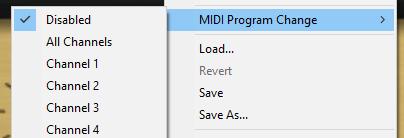
Next / Previous Program
For controllers that do not support program change and bank select protocols, starting with version 1.6 you can also navigate thru presets by assigning the next and previous preset commands to MIDI CC messages:

FX Bypass
Individual FX bypass can be controlled via MIDI: you can quickly assign the controller via MIDI learn, like for any other parameter.
You can either assign your controller to physical slots bypass controls (in the edit view), or to logical footswitches in the EZ view (pedalboard section) that follow effects, wherever they have been loaded:
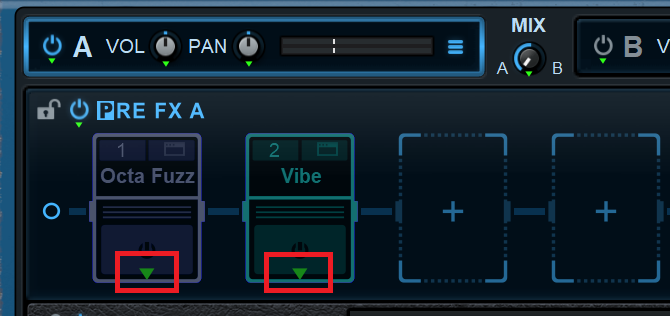

When adding/removing effects, the assignments in the EZ view will automatically switch to the effects loaded in order (wherever they are), whereas with the full edit view assignments, the MIDI controller is linked to the physical location (the plug-in slot). So for example when removing an effect in slot, the associated controller will not control any effect at all anymore (switching an empt slot), whereas if it had been assigned to footswitches in the EZ View, it would now control the effect in the next non-empty slot (if any).
Individual Parameters
Individual parameters inside Axiom (and each built-in plug-in) can be controlled via MIDI CC. Some third party plug-ins may also support this feature.
However, it is recommended to use mapped parameters to control the effects loaded into Axiom instead: with this method, you can change presets for these plug-ins independently from MIDI control settings. There parameters will also be available for automation control when using Axiom as a plug-in in your favorite DAW, and they will be dislpayed in the EZ Mode too. It is also easier to see which parameters are actually in use for MIDI control when reloading a session later... It also applies to the amp simulation modules.

Here is the full procedure:
- Map the parameters you want to control via MIDI with the "Params Map" plug-in menu item (more details in the previous chapter).
- Display mapped parameters and MIDI controls using the appropriate toolbar icons.
- For each parameter, click on the green arrow below the knob to perform MIDI learn or manually set the MIDI configuration (including parameter range, response curve etc.).
Typical use cases: control the bypass switch for each pedal with foot-switches (no mapping required - it is an Axiom parameter), the position of the Wah or Pitch Bender with an expression pedal (mapping recommended).
Locking Control Settings
When using a foot controller to load Axiom presets, if you are not using global MIDI settings (shared accross the system), you may want to lock MIDI control settings, so that they are not modified when loading presets:
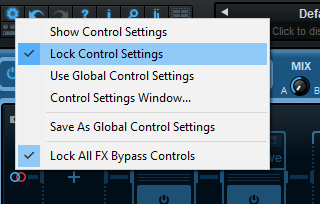
It may also be convenient to lock the state of all effects bypass buttons (as shown above), so that they are not affected by preset changes, and match the state of your foot controller. This lets you both load presets and activate/deactivate pedals individually with a controller and keep the software and the on/off state of each footswitch in sync.
Note: the state of these locks can be saved in the default preset, using the Save As User Default command.
Dual Input
Sometimes you may want to use channel A and B separately, each one processing a different audio input: for example, if your instrument has a stereo output (piezo and magnetic guitar pickups, Chapman stick...), or if you want to play with two instruments at the same time (remember when you plugged two guitars in the same amp back in the days?).
Using plug-ins audio I/O routing, it is fairly easy to to do this in Axiom: check the "dual input" factory presets. they use a simple gain plug-in in the first pre-slot of each channel. For channel A, it is configured to receive only channel 1 (left), whereas the gain plug-in in channel B processes only the second channel (right). Here you go! You have two separate signal chains, each one processing a different input!
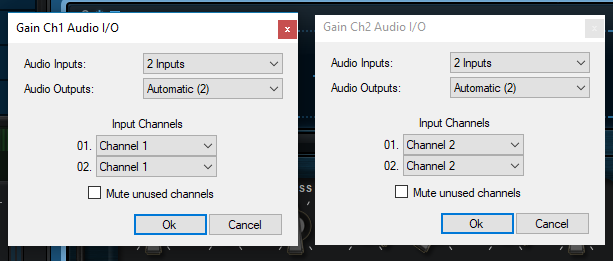
Note: this requires a stereo audio input.
Mono Effects
When using a stereo configuration, with the audio I/O panel, you can apply different effects to the left and right channels:

It is strongly recommended to rename the plug-ins according to the channel they apply to, as shiwn in the above example.
Additional Tips
Lock the Gate
You may want to lock the gate in the amp simulation editor so that it does not change when loading amp simulation presets: once it has been setup properly (or disabled), you may want to keep the settings that work for you regardless of the select amp.
Pan Amp Sim Channels
You can hard-pan amp sim channels left and right and then adjust the stereo width to blend both sounds in the middle using the master spread control.
Switch between Channels A and B
You can use channels A and B like amp channels in the real world, but with different effect pedals if you want. Assign the A/B mix parameter to a MIDI footswitch, and use channel B when taking the lead, reserving channel A for rhythm parts!
Save Presets
It is recommended to save your favorite effect chains, amp simulations and channel configuration as presets: this will save you a lot of time when creating new tones. Axiom was designed to help you reuse your work: don't re-invent the wheel everytime!
Also, you should save your favorite third party plug-ins configurations with the "Save As..." menu item: they will appear in the plug-in menu so that you can load them faster.
Use Destructor for More Amp Sims / Distortion Pedals / Cabs
You can instantiate the built-in Destructor plug-in anywhere in the signal chain to create more advanced routings: you can for example use ony the "preamp" section of the plug-in in the input slots, and enable only the destruction and post filters of both built-in amp sims. Just like plugging a preamp into two different power amps and cabinets in the real life!
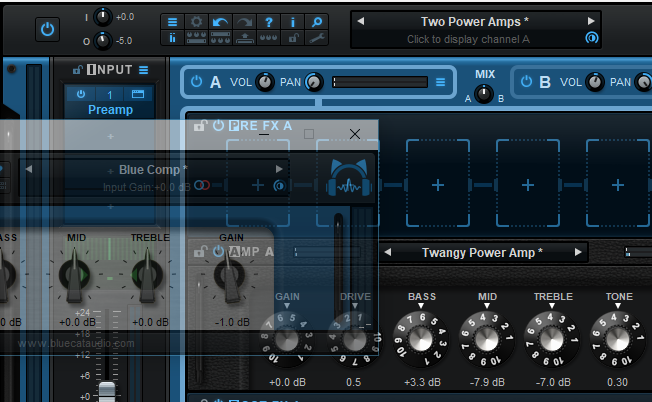
The post-filter section can also be used alone as separate cabinet simulations.
Additional instances of Destructor will also let you add more distortion pedals to your arsenal: check out the included pedal presets and build your own from there!
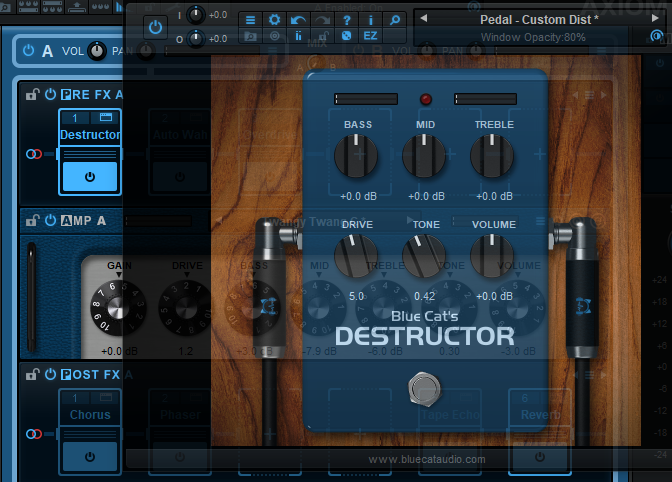
Load Cabinets or Reverb Impulse Responses with the built-in EQ
The built-in EQ plug-in can load and manipulate impulse responses (IR), just like the built-in IR loader in Destructor. So if you just want to use an impulse response for a cab simulation anywhere in the signal chain, just load the built-in EQ and drag and drop the IR onto it!
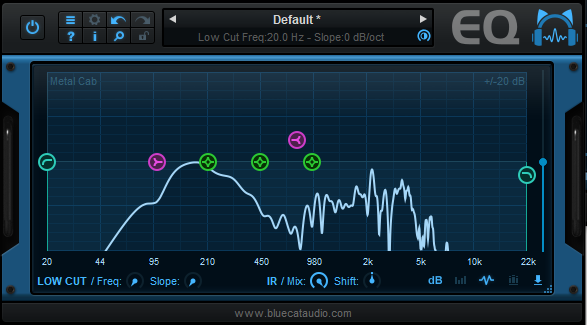
Change the Tone of Your Guitar With the Input Strip
Using the input strip, it is possile to change the tone of your guitar before it reaches the amp channels. So you can use this section to adapt the signal of your guitar before applying other effects. Check out the "Re-Guitaring" presets or the other included input strip presets, such as "Humbuckerizer", "Single Coilizer", "12 String Acoustic" and tweak them to your taste!
Once you like the new tone of your guitar, you can lock the input section and browse the presets!
Multiband Amps and Effects
You can also use the two parallel channels to perform multiband distortion (use different amps and/or effects for bass and treble): Just insert an EQ as the first pedal in the pre-fx section for both channels. Set up the first one as a lowpass filter (to process only bass) and the other one as a high pass filter (to process only treble). You can then adjust the filters depending on how you want to split the signal. Check the "Dual Band" factory presets to get an idea!
If you want more bands, you can load the PatchWork plug-in inside Axiom, woth the same approach, just more different filters (it has up to 8 parallel chains). Or you can try the MB-7 Mixer plug-in, that provides a complete multiband infrastructure with perfect split and reconstruction of the signal.
Standalone Application Basics
Main Features
The standalone application will let you process audio data coming from the inputs of the audio interface and stream it to its output, in real time, without the need for a third party host application. The application also receives MIDI events from all MIDI input interfaces available on the machine, without any particular configuration required.
The core features of the application are the same as the plug-ins versions, except that the application can run on its own.
It is worth noting that user presets are shared between the standalone application and the plug-ins versions, so that presets can be reused between standlone and plug-in sessions.
Application Preferences
The audio/MIDI setup for the application is decribed in details in the first launch chapter.

The configuration window above can be displayed using the Edit/Audio Setup menu item. More information about the various fields can be found in the first launch chapter.
Application Menu
The application menu gives you access to the following commands:
- Edit/Undo: undo last change.
- Edit/Redo: redo last undone change.
- Edit/Audio Setup: open the preferences window.
Keyboard Shortcuts
To speed up operation, several keyboard shortcuts are available in the standalone application:
On Windows
- CTRL+Z: undo.
- Shift CTRL+Z: redo.
- CTRL+P: open the preferences window.
- ALT+F4: quit the application.
On Mac
- CMD+Z: undo.
- Shift CMD+Z: redo.
- CMD+, or CMD+P: open the preferences window.
- CMD+Q: quit the application.
Troubleshooting
No Sound
if you cannot hear anything coming out of the software, you need to check the audio configuration: open the preferences window (Edit Menu / Audio Setup command), and check that the audio engine is running. If it is not running, you may need to select another audio interface or change the buffer and sample rate settings. If it is running, you may want to select another audio interface or differnt audio inputs and outputs.
Cracks and Pops
If you can hear unwanted "cracks" and "pops" during the performance, you may be experiencing audio dropouts, because the application is using too much CPU. You can try to increase the buffer size in the preferences window to reduce CPU usage, and close other applications that are currently running.
Blue Cat Audio Plug-Ins Basics
This chapter describes the basic features that are common to all our plug-ins. If you are already familiar with our products, you can skip this part.
User Interface Basics
About Skins
Like all Blue Cat Audio plug-ins, Blue Cat's Axiom uses a skinnable user interface. It means that the appearance and behavior of the user interface can be entirely customized.
Especially with third party skins, the experience may be quite different from the one offered by the default skins that we provide. However, our plug-ins and our skinning engine have several standard features that will be available whatever your favorite skin.
More information about custom skins can be found in the skins section.
The Main Toolbar
In most skins, an optional toolbar at the top of the user interface gives you access to the main options and settings of the plug-in:

Smooth Bypass
On the left, the power button can be used to smoothly bypass the plug-in.
Presets Area
At the center of the toolbar, you can see the current preset area (the "Default Settings" box). It displays the name of the current preset, with a "*" at the end if it has been modified since loaded.
The arrows on the left and right let you navigate thru the (factory and user) presets available for the plug-in.
Clicking on the preset name opens the presets menu which lets you manage the presets of the plug-in.
Using the knob on the bottom right of this area, you can reduce the opacity of the window, and make it transparent (the actual result may depend on the host application). Additional messages may appear in the area next to this knob, depending on the plug-in.
Some plug-ins may also propose you to manually select the audio I/O inside the plug-in (bottom left of the presets area), regardless of the host configuration. It can be useful for example to save CPU by selecting mono to stereo configurations (instead of full stereo sometimes chosen by default by the host), or add extra channels to manage side chain internally, when the host does not provides any side chain input. Please note that this does not change the number of I/O seen by the host application.
Commands
The icons in the toolbar give you access the to the following commands that are detailed in the next paragraph:
| Icon | Name | Function |
|---|---|---|
|
|
Menu | Open the main menu |
|
|
Control Settings | Display the controls settings menu (to manage automation and MIDI control, as described here). |
|
|
Undo | Undo |
|
|
Redo | Redo |
|
|
Manual | User Manual |
|
|
About | About |
|
|
Zoom | Scale the user interface (from 70% to 200%). |
The Main Menu
The main menu is available from the main toolbar, or if you right click anywhere on the background of the plug-in:
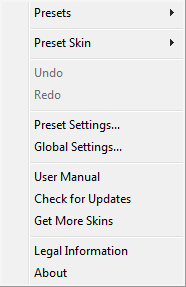
- Presets: opens the presets menu to manage presets.
- Preset Skin: opens the skins menu to choose the skin for the current preset and manage alternative skins for the software.
- Undo/Redo: undo or redo the latest modifications. This includes all changes made to the current preset settings such as MIDI or automation preferences.
- Presets Settings: open the presets settings window. It lets you change the skin, MIDI and automation settings for the current preset.
- Global Settings: open the global settings window. It lets you change the skin, MIDI and automation settings that are used by default in all instances of the plug-in (if not overridden by the current preset).
- User Manual: open this user manual.
- Check for Updates: opens up our website to let you check if any update for this software is available.
- Get More Skins: get more skins for this software.
- Legal Information: browse licensing and misc legal documents.
- About: displays the “about” dialog box.
Controls
Examples
Here are a few examples of typical controls you will encounter in the user interface of our plug-ins:
| slider | slider | knob | button | Text control |
|
|
 |
 |
|
|
Interacting with Controls
You can interact with the controls of the plug-in interface either with the mouse or the keyboard.
Setting the keyboard focus on a control (so that it responds to key strokes) may be automatic (when you pass the mouse over it it gets focus) or manual (you have to click on the control to set the focus on it). Note that all host applications behave differently regarding keyboard handling. In some applications you may not be able to use all keys described later in this manual to interact with our plug-ins. It is usually made obvious to you to know the active surfaces of the skin (the places where you can click with the mouse): the mouse cursor usually changes when you can do something on a control. In the default skins delivered with the plug-in, the cursor changes to a small hand or an arrow to tell you when your mouse is over an active control.
Mouse
Various mouse movements will let you interact with the controls:
| Mouse Interaction | Action |
|---|---|
| Left Click | Acquire focus and start dragging or push (button) |
| Left Click + Alt Key | Set the value to default |
| Left Double Click |
Acquire focus and launch the “fine
tuning” edit box (except button):
 |
| Right Click | Set the value to default |
| Mouse Wheel | Increment or decrement the position (focus required) |
| Mouse Drag | Change the control position depending on mouse movement (except button) |
Keyboard
All control widgets support the following keys (note that some of them are caught by the host and thus never forwarded to the control. For example in Steinberg Cubase SX you cannot use the arrow keys to control the plug-in):
Keys Common to All Controls
| Key | Action |
|---|---|
| Up Arrow | Small increment of the position (up or right) |
| Down Arrow | Small increment of the position (down or left) |
| Left Arrow | Same as Down Arrow |
| Right Arrow | Same as Up Arrow |
| Page Up | Large increment of the position (up or right) |
| Page Down | Large decrement of the position (down or left) |
| + | Small increment of the value of the control |
| - | Small decrement of the value of the control |
| d | Set to default value (same as mouse right click) |
| e |
Opens the 'fine tuning' window to precisely
set the parameter:
 |
| SHIFT | When the key is down, the fine tuning mode is on, and you can modify the value with better precision when moving the mouse, the mouse wheel or using the keyboard. Just release the key to get back to the normal mode. |
Keys Specific to Buttons
| Key | Action |
|---|---|
| Enter | Pushes the button |
Presets
To get started with the plug-in and discover its capabilities, a couple of factory presets are provided. You can also save your own presets and recall them later for other projects. Our plug-ins propose a full-featured preset manager to let you save, browse, organize and recall its presets.
The Presets Menu
The presets menu can be opened from the main menu or the main toolbar. It displays the list of presets available for the plug-in as well as commands to load, save or organize presets:

- Factory Presets: shows the list of factory presets delivered with the plug-in.
- "Folder A" to "User Preset Z": user presets and categories.
- MIDI Program Change: activate MIDI Program Change support (see below).
- Load: load preset from file.
- Save: save current state to last loaded user preset.
- Save As: save current preset to a file.
- Copy copy preset to the system clipboard.
- Paste paste preset from the system clipboard, if available.
- Save As User Default: save the current state as the default preset. This preset is used every time a new instance of the plug-in is created.
- Clear User Default: reset the default preset to its factory state: this makes the plug-in forgets the custom settings you might have saved as a default preset.
More about Presets
There are two types of presets: factory presets (read only) that are provided with the plug-in, and user presets that can be created and stored by the user.
The user presets are stored in a subdirectory of the documents folders of your profile ("Documents" on Mac, and "My Documents" on Windows): Blue Cat Audio/[Plug-in Name]/Presets. Each preset is stored as an individual file. You can create folders and subfolders in the Presets directory to classify your presets, as shown in the example below:

If you save a preset named "Default" in the root Presets directory, it will override the factory default preset (that's what "Save As Default" does). To restore the factory default preset, you can just remove this file or use the "Reset Default" command.
MIDI Program Change
It is possible to load presets remotely using MIDI "Bank Select" and "Program Change" messages. To enable this feature, select a MIDI channel to receive the events from in the MIDI Program Change menu item from the presets menu:

This setting is saved for each plug-in istance with your session but not in presets (except for the default preset, using the "Save as User Default command"). Once activated, the plug-in menu will display the bank number followed by the preset number for each preset:
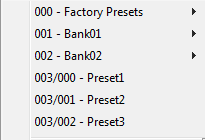
Every root folder is considered as a new bank, starting with the factory presets (bank 0). Program and bank numbers may change while you add folders and presets, so you should be careful when naming them if bank and program numbers matter to you. It is recommended to use folders to make this task simpler. As a side note, sub folders do not define additional banks (all presets contained in sub folders are associated with the current bank.
As specified by MIDI, bank select messages are not used until a program is actually selected.
MIDI Implementation note: the software supports all types of Bank Select methods. You can use either MIDI CC 0 or MIDI CC 32 to select banks. If both are used simultaneously, they are combined together so that you can use more banks (in this case CC0 is LSB and CC32 is MSB, and actual bank number is 128*CC0+CC32).
MIDI and Automation Control
Blue Cat's Axiom can also be remotely controlled via MIDI using MIDI CC ("Control Change") messages or automation curves, if your host application supports it. It is possible to customize the channel, control numbers, range and response curve used for each parameter in the settings panel available from the main menu (see the Plug-in Settings chapter for more details).
MIDI and Automation Settings Menu
The main menu
Most skins also provide the ability to change MIDI and automation settings directly in the main user interface. Clicking on the control settings icon in the main toolbar opens the following menu:
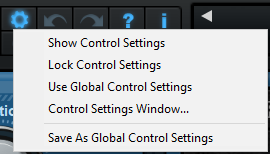
- Show Control Settings: show direct access to individual control settings for each parameter in the user interface (see next paragraph).
- Lock Control Settings: lock the current controls settings for MIDI and automation so that they remain unchanged when loading presets.
- Use Global Control Settings: ignore the current MIDI/automation settings and use the global settings instead.
- Control Settings Window: display the control settings window, to change control settings for all parameters.
- Save As Global Control Settings: save the current settings as global settings (used by default, when no specific MIDI/Automation setting has been set for the cuirrent preset).
Individual Control Settings
When this feature is activated using the "Show Control Settings" item in the MIDI and Automation Settings menu, dropdown menu buttons appears next to the main controls displayed by the plug-in:
Clicking on this button shows the MIDI/Automation settings menu:
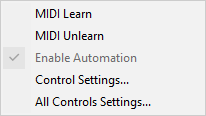
- MIDI Learn: launches MIDI learn mode for the control: touch your MIDI controller and the control will learn from it the MIDI channel and CC number. To end the learn mode, reopen this menu and deselect the option.
- MIDI Unlearn: deactivates MIDI control for this parameter.
- Control Settings: launches the advanced settings panel described below. This controls the settings for the current preset.
- All Control Settings: display the control settings window, with access to all parameters.
Advanced MIDI and Automation Settings
You can completely customize the way the plug-in is controlled by automation and MIDI. For a global view of all parameters at a time, you can use the Plug-in Settings window for the current preset which is available from the main menu.

MIDI Settings:
- Enable MIDI: enable/disable the MIDI control of the parameter.
- Channel: MIDI Channel for the parameter control. If set to 0, the plug-ins will accept Control Change Messages from all MIDI Channels (MIDI Omni mode).
- CC: Control Change Number.
- Learn: click on this button to activate the MIDI learn functionality. When it is activated, you can move your MIDI controller, and the plug-in will automatically set the MIDI Channel and CC Number.
MIDI and automation settings:
- Response: response curve of the MIDI or automation control: from very fast to slow control.
- Min: minimal value of the parameter when MIDI controlled or automated.
- Max: Maximum value of the parameter when MIDI controlled or automated.
Note: if the Min value is higher than the Max value, the response curve will be reversed: increasing the control value will decrease the parameter value.
Note: if you double click on the parameter text control boxes for the max and min values, a “fine tuning” edit box will appear and let you change the min and max values with more precision:

More
Check our online tutorial for more screenshots and more examples of our plug-ins user interfaces.
Blue Cat's Axiom Parameters
All parameters described below can be automated and controlled via MIDI if your host application supports it. You can precisely define this behavior in the settings panels described later in this manual.
The parameters of this plug-in exposed for automation and MIDI control are described below:
| Name | Unit | Description |
|---|---|---|
| General | ||
| Bypass |
|
Bypass the effect. |
| Meters On |
|
Enable or Disable level meters. |
| Input Section | ||
| In Gain | dB | Input gain, right at the input of the plug-in, before any processing occurs. |
| Tuner On |
|
Enable or disable the tuner. |
| In Bypass 1-4 |
|
Bypass input plug-in slots 1 to 4. |
| Pre Gain | dB | Gain at the end of the input section. |
| Channel A | ||
| A Enabled |
|
Enable or disable channel A. |
| A Pre |
|
Enable or disable the Pre effects section of channel A. |
| A Pre Bypass 1-6 |
|
Bypass pre fx plug-in slots 1 to 6 for channel A. |
| A Amp Bypass |
|
Bypass the amp simulation module for channel A. |
| A Post |
|
Enable or disable the post effects section of channel A. |
| A Post Bypass 1-6 |
|
Bypass post fx plug-in slots 1 to 6 for channel A. |
| A Pan | % | Pan pot (left-right panning) for channel A. |
| A Gain | dB | Output gain for channel A. |
| Channel B | ||
| Same as Channel A | ||
| A/B | ||
| A-B Mix | % | Relative mix of A and B channels (-100% is A only, 0% is A+B, and 100% is B only). |
| Master | ||
| Mast Bypass 1-4 |
|
Bypass master plug-in slots 1 to 4. |
| Mast Gain | dB | Master gain at the end of the guitar signal chain, before the brickwall limiter. |
| Limiter | On/Off | Enable or disable the 0 dB brickwall limiter. |
| Tools Slots | ||
| T1-3 Bypass |
|
Bypass tools instrument slots 1 to 3. |
| T1-3 Gain |
|
Output gain for tools instrument slots 1 to 3. |
| Out Gain | ||
| Out Gain |
|
Gain at the output of Axiom, after the master signal and tools instruments have been mixed together. |
| Assignable Controls | ||
| Control 01-44 |
|
Extra controls for assigned parameters (aka "Macro" parameters). |
| Additional Parameters | ||
| Spillover |
|
Anable/disabled spillover for Axiom sections (playing effect tails when bypassed). |
| Multicore |
|
Enable/disable multicore processing. |
| Mute |
|
Mute Axiom's audio input. |
| Assignable Footswitches | ||
| FW 01-35 |
|
EZ View footswitches controls. Enable/disable loaded plug-ins (dynamically affected in order, only for slots containing a plug-in). |
Plug-in Settings
In addition to the controls offered in the main user interface, Blue Cat's Axiom has various settings that let you fine tune the behavior of the plug-in. You can choose to change these settings either for the current preset or globally for all instances of the plug-in.
The Global Settings Window
The settings available in this window apply to all instances of the plug-in, for all presets, if not overridden in the presets settings. Consider these settings as “default” settings.
General
You can change the default skin for all instances of the plug-in: write the skin file path in the text edit box or click on the button to open a file chooser dialog. If you have several instances of the plug-in opened in your session, you will have to re-open the user interfaces of these plug-ins to see the skin change.
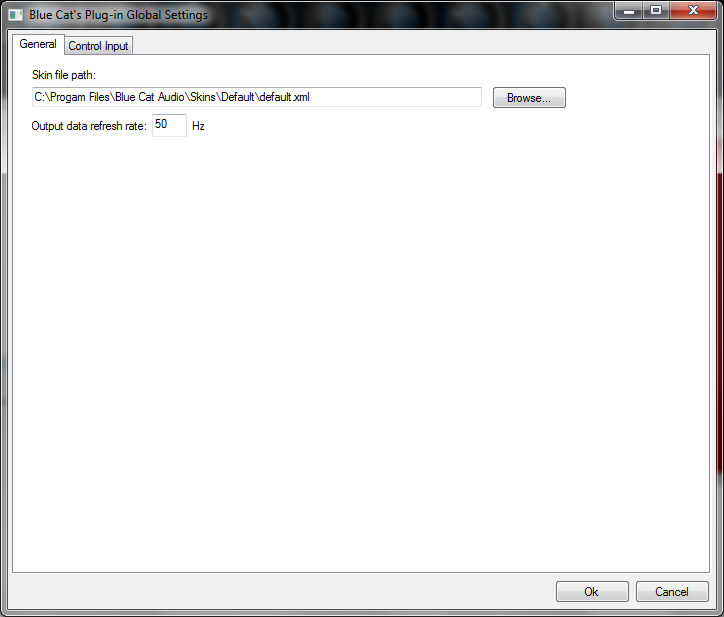
The output data refresh rate can also be customized for all instances of the plug-in. It controls the refresh rate of non-audio data produced by the plug-in (parameters, curves...). It also controls the refresh rate of output MIDI CC messages or output automation data. The higher the refresh rate, the better precision, but also the higher cpu usage (some host applications may also have trouble recording MIDI data at high refresh rates). The default value is 50 Hz.
Global Control Input Settings (MIDI and Automation)
The plug-in offers a couple of settings that affect the way it is controlled by MIDI messages or automation. While the first settings only apply to MIDI control, the "Control Response", "Min" and "Max" settings apply to both automation and MIDI control.
For each parameter you can define a default MIDI channel and CC number. You can then control the plug-in with an external MIDI controller or one of our plug-ins that generate MIDI messages.
The settings below are available for each plug-in parameter.
MIDI Settings:
- Enable MIDI: enable/disable the MIDI control of the parameter.
- Channel: MIDI Channel for the parameter control. If set to 0, the plug-ins will accept Control Change Messages from all MIDI Channels (MIDI Omni mode).
- CC: Control Change Number.
- Learn: click on this button to activate the MIDI learn functionality. When it is activated, you can move your MIDI controller, and the plug-in will automatically set the MIDI Channel and CC Number.
MIDI and automation settings:
- Response: response curve of the MIDI or automation control: from very fast to slow control.
- Min: minimal value of the parameter when MIDI controlled or automated.
- Max: Maximum value of the parameter when MIDI controlled or automated.
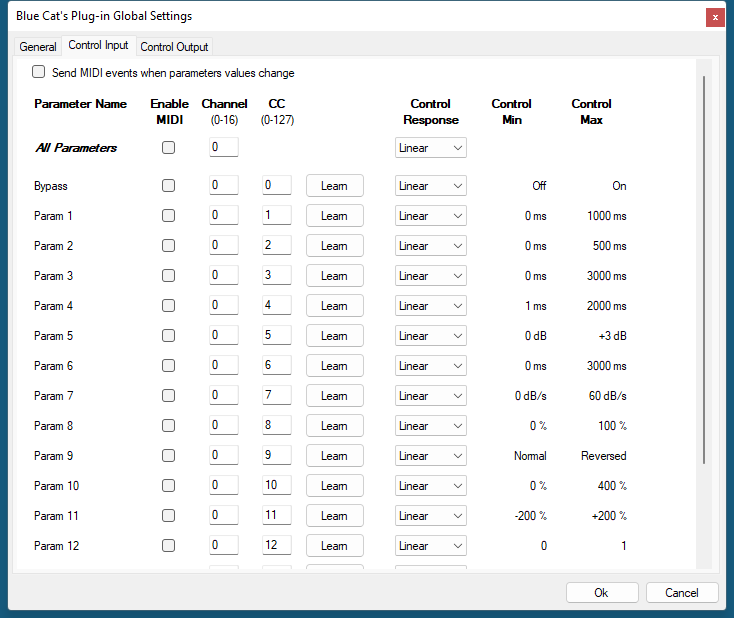
Note: if the Min value is higher than the Max value, the response curve will be reversed: increasing the control value will decrease the parameter value.
Note: if you double click on the parameter text control boxes for the max and min values, a “fine tuning” edit box will appear and let you change the min and max values with more precision:

"Send MIDI events when parameters values change": activate this option when using a control surface that accepts MIDI events as input. MIDI messages will be sent to the output of the plug-in when the user change the parameters values in the user interface, to keep the software and the controller in sync. MIDI is only sent for parameters that are activated for MIDI control.
The Current Preset Settings Window
In this window you can change the settings for the current preset of the current instance of the plug-in only.
Preset Skin
You can choose to use the global skin setting or to change the skin for the current preset. This way you can have different skins for different instances of the plug-in in the same session in order to differentiate them.
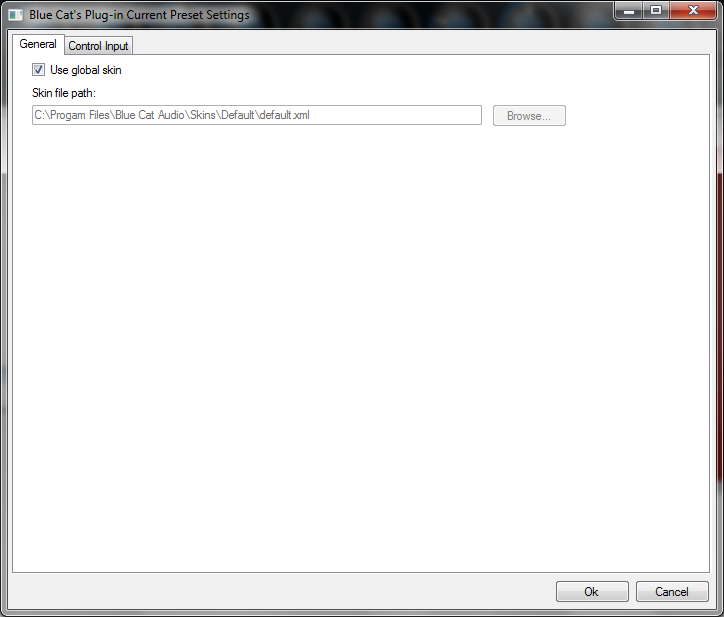
Preset Control Input Settings (MIDI and Automation)
Use the global settings or override them for the current preset. The parameters are the same as for the global input settings.
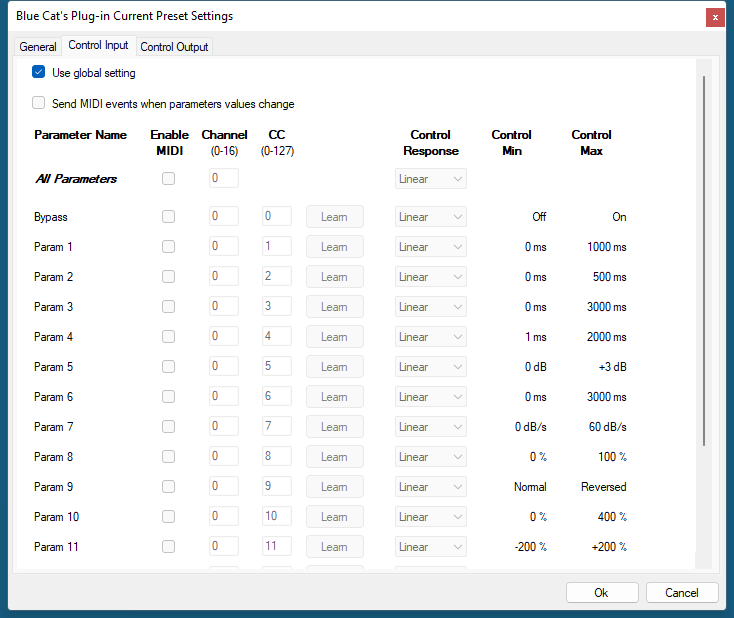
About Skins
Blue Cat's Axiom integrates Blue Cat's skinning engine that allows you to customize the user interface. You can download alternate skins for your plug-in at the following address:
If you don't find a skin that fits your need or if you want a custom one, you can choose to create your own skin.
Choosing the Skin
There are two ways to select the skin of your plug-in: you can change the default (or 'global') skin, or change the skin for the current preset only (either in the preset settings page or from the main menu). The global skin applies to all plug-in instances (choose this one if you want to use the skin used by default, regardless of the session or preset), whereas the current preset skin only applies to the current preset of the current plug-in instance (use this one if you want to change only the skin for the current session/preset).
Note: in some host applications, the plug-in window won't resize automatically when you choose a skin with a different size. In this case, just close the window and re-open it: it will be displayed with the right size.
The Skins Menu
The skins menu can be opened from the main menu. It displays the list of skins available for the plug-in as well as commands to manage the skin used by default when no preset skin has been selected:

- First Section - Factory Skins: shows the list of factory skins delivered with the plug-in ("Default" and "Light" in this example).
- Second Section - User Skins: shows the list of user skins that have been installed in the Documents Skins folder for the plug-in (see below).
- Use Global Skin: use the global skin for the current preset/session (unloads any custom skin previously selected for the current preset).
- Load: opens a file browser dialog to manually select the skin from the file system.
- Save As Global Skin: use the current preset skin as the global skin (loaded by default if no preset skin has been defined).
Installing User Skins
To select user skins directly from the skins menu, install them in the "Skins" directory available in the plug-in's documents folder:
[Your Documents Folder]/Blue Cat Audio/[Plugin Name]/Skins/
The skin engine will scan this folder for new skins (xml files) and display them in the menu. The skin files should be in the root skins folder or in a subdirectory inside this folder: subdirectories are not scanned recursively.
Other Methods to Select Skins
You can also select the skins in the settings panels available from the main menu:
The global skin (used by default if no preset skin has been selected) can be changed in the global settings pane. The current preset skin can be changed in the preset settings page .
Create a Custom Skin
You can create custom skins for your plug-in in order to adapt it to your exact needs. You can change its look and feel and make it completely integrated in your virtual studio!
Just read the Blue Cat's Skinning Language manual and download the samples for the tutorial on http://www.bluecataudio.com/Skins. You can get ready to create your own skins in a few minutes. You can then share your skins on our website.
More...
This manual only covers the main aspects of Blue Cat's Axiom. Our website offers many additional resources for your Blue Cat's Axiom plug-in. It is constantly updated, so keep an eye on it!
Updates
As you can see in the history log below, we care about constantly updating our products in order to give you the latest technology available. Please visit our website often to check if Blue Cat's Axiom has been updated, or subscribe to our Newsletter to be informed of the latest news about our products.
Note: minor version updates are available from the same location as the original full version download (link received by email upon purchase). The demo version publicly available on our website will not let you register.
You can also follow us on twitter, facebook and instagram for almost real time updates notification, and subscribe to our YouTube channel to watch the latest videos about our software.
Versions History
V2.1 (2024/09/09) |
|
V2.07 (2024/04/10) |
|
V2.05 (2023/11/07) |
|
V2.0 (2023/09/12) |
Axiom V2 represents a major leap forward in our guitar software, bridging the gap between beginners seeking user-friendly features and advanced users craving expanded capabilities. Redesigned User Interface:
|
V1.65 (2022/12/12) |
|
V1.62 (2022/03/28) |
|
V1.61 (2021/11/02) |
|
V1.6 (2021/06/29) |
New Features & Improvements:
|
V1.5 (2020/10/05) |
New Features & Improvements:
|
V1.41 (2020/05/28) |
|
V1.4 (2020/02/03) |
|
V1.32 (2020/01/06) |
New Features & Improvements:
|
V1.31 (2019/09/25) |
|
V1.3 (2019/09/23) |
New features:
|
V1.2 (2019/03/12) |
|
V1.12 (2018/12/06) |
|
V1.11 (2018/10/19) |
|
V1.1 (2018/10/09) |
|
V1.0 (2018/04/19) |
First release. |
Thanks again for choosing our software!

See you soon on www.bluecataudio.com!

